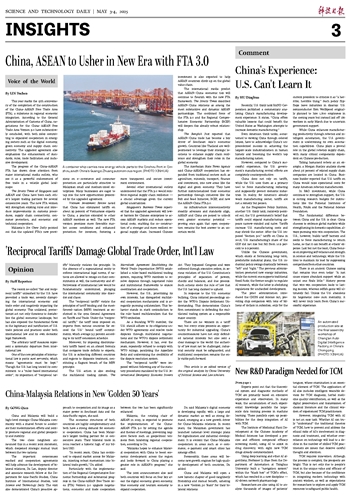
 |
| An automated production site at the final assembly workshop of Chang'an Auto Digital Intelligence Factory, in China's Chongqing. (PHOTO: XINHUA) |
Recently, U.S. think tank RAND Corporation published a commentary analyzing China's manufacturing development experience. It states, "China offers valuable lessons that could benefit the United States as Washington attempts to increase domestic manufacturing."
Even American think tanks, accustomed to viewing China through colored lenses, have to acknowledge China's unprecedented success in achieving the largest-scale industrialization in human history and becoming the world's top manufacturing nation.
However, compared to China's successful experience, the U.S. government's manufacturing revival efforts are completely counterproductive.
China does not rely on tariffs, while the U.S. uses them as a primary tool to force manufacturing reshoring and supposedly protect domestic industries. In reality, for America's already weak manufacturing sector, tariffs are not a remedy but poison.
As the Progressive Policy Institute, another U.S. think tank, incisively pointed out, the U.S. government's belief that tariffs could expand manufacturing appears narrow-minded and na?ve. Tariffs increase U.S. manufacturing costs and may shrink the sector. After the U.S. imposed "Section 301" tariffs on China in 2018, U.S. manufacturing's share of the GDP did not rise but fell from 10.9 percent to 9.9 percent.
Unlike the Chinese government, which excels at formulating long-term, predictable industrial plans, the U.S. industrial policy swings drastically between "left" and "right." The previous administration promoted new energy industries, while the current one supports traditional fossil fuels; the former sought to regulate AI research, while the latter is abolishing regulations for unchecked development.
The prior administration introduced the CHIPS and Science Act, providing chip companies with tens of billions of dollars in subsidies, only for the current president to criticize it as "a horrible, horrible thing." Such policy flip-flops leave industries in disarray. U.S. semiconductor firm Wolfspeed originally planned to hire 1,800 employees in the coming years but instead laid off 180 workers in early March due to uncertain government support.
While China enhances manufacturing productivity through robotics and intelligent automation, the U.S. government is undermining its own automation capabilities. China plays a pivotal role in the global robotics supply chain, with many critical components dependent on Chinese production.
Taking humanoid robots as an example, a Morgan Stanley analysis shows about 56 percent of related supply chain companies are located in China. Business Insider reported that U.S. tariffs on China would raise operational costs for many American robotics manufacturers.
In R&D investment, while China continues to strengthen support, the U.S. is cutting research budgets for institutions like the National Institutes of Health, NASA and the National Science Foundation.
The fundamental difference between China and the U.S. is clear. China chooses to embrace global markets while strengthening its domestic capabilities, always pursuing win-win cooperation. The U.S., however, builds tariff barriers and seeks to force manufacturing to return home, so that it can benefit at others' expense. Last but not the least, China focuses on improving self-reliance and strength in science and technology, while the U.S. tries to maintain its lead by suppressing competitors from other countries.
There is an ancient Chinese saying that remains true even today: "A just cause enjoys abundant support while an unjust one finds little." History proves that win-win cooperation leads to lasting success, whereas selfish gains will ultimately fail. Unless the U.S. abandons its hegemonic zero-sum mentality, it will never truly learn from China's successful experience.


 Next
Next




